The age-old adage that every man’s home is his castle came true for William Randolph Hearst in San Simeon, California, on a piece of property known as La Cuesta Encantada or “The Enchanted Hill.”
In the late 1890s when the tiny village of San Simeon had a population of just over 300 people, Hearst began acquiring land with the intent of building a mountain lodge for his family and close friends. However, his vision expanded, and he transformed the estate into a lavish mansion, known today as Hearst Castle. The grand structure reflects Mediterranean and Spanish architectural styles and features. The main residence, known as “La Casa Grande,” has 115 rooms, including 38 bedrooms and more than 40 bathrooms. It also has a theater, game room, library, and beauty salon.
Surrounding the main residence are three guest houses; Casa del Mar, Casa del Monte, and Casa del Sol where there are twenty more bedrooms and eighteen bathrooms.
Each room is lavishly decorated with items from Mr. Hearst’s art collection. Hearst was a master collector, he literally owned one, maybe two, or a dozen of everything. There is a story the Hearst Castle docents tell about one occasion when Mr. Hearst saw a picture in an antiques magazine of a British tea set that he liked. He instructed his agent to purchase it. Time passed, perhaps weeks, and he remembered that he had ordered his agent to buy the tea set. His inquiry brought him an answer he didn’t expect … he already owned that very tea set and it had been in a San Francisco warehouse for over a decade.
Construction began at San Simeon in 1919 under the very watchful eye of the widely known architect Julia Morgan. In retrospect, estimates have been implied that in period-value dollars (from the 1920s to 1940s) the complex could be in a range from $7 million to $8.5 million. Morgan’s fees for twenty-odd years of almost continuous work, came to $70,755. Her initial fee was a 6% commission on total costs.
Hearst Castle symbolizes Hearst’s wealth and ambition, and today, it is the third highest income property in the California Park System at well over $1 million annually. However, the costs to California taxpayers far exceeds its income and since 2013 there has been nearly $60 million in deferred maintenance costs that has diminished but very slowly.
***
Postcards of San Simeon began to appear in the early 1950s. The castle façade and its interiors, as well as many items in Hearst’s collection were perfect items to be shown on the relatively new chrome postcard. There were probably more than four manufacturers that printed postcards, but four companies made the lion’s share:
dp – Dexter Press of West Nyack, New York won the honor of being the official publisher of San Simeon postcards. (There is speculation that the Dexter set has at least 60 issues.) The Dexter cards that were distributed by the GT Company of Cambria, California, used a 5/8” sketch of the Casa Granda as a logo at the bottom of the divided-back separator.
The Richard Blake Printery of nearby San Luis Obispo, that had established a sterling reputation for printing wine bottle labels, joined the postcard world in the mid-1960s. They named their product the Penny Color Postal. The Blake postcards are ever so-slightly brighter, but the quality of their cardstock was somewhat lighter weight.
Plastichrome by Colourpicture Publishers of Boston, Massachusetts, also made San Simeon postcards of equal color and on equal cardstock. The Plastichrome cards were also distributed by a Cambria, California, firm – P. J. Jones.
And, since we’re examining California chrome postcards, we would be remiss to not mention the Natural Color postcards made by Mike Roberts. The Roberts postcards were distributed by Bob Ball of Visalia, California.
Examples of these four publisher’s cards follow with edited captions.
This Remarkable Portrait of William Randolph Hearst was painted in 1894 by Orrin Peck. It shows Mr. Hearst at the age of 31 and is displayed in his Gothic Study in La Casa Grande.
Hearst Castle is situated high on a peak overlooking the broad Pacific. It contains rooms in which are located treasures gathered from throughout the world.
San Simeon Monument. The towers and façade at Hearst Castle gleam in the soft California night. These and other Enchanted Hill lights once served as navigational aids to ships passing by in earlier years.
The Gothic Suite. Hearst’s own bedroom is the smallest, but by no means the humblest. Its ceiling, the rarest and most unusual at San Simeon is a 14th century Gothic work from the House of Jews in Tervel, Spain. Above the dresser hands one of the Castle’s most acclaimed paintings, a 14th century gold-laden Madonna by Segma.
This aerial view of the Enchanted Hill shows the three guest houses and terraced gardens surrounding the La Casa Grande or Hearst Castle. 123 acres of grounds contain statuary, pools, and rare works of art.
The Santa Lucia Mountains form a dramatic backdrop for the Neptune Pool. Venus, in Carrara marble, gazes across the pool to a Greco–Roman Temple that is pre-Christian in origin.
The Refectory. A favorite of Hearst, his refectory successfully marries a variety of architectural elements and superlative furnishings into a medieval yet welcoming whole. Along with lavish silver candlesticks and gold-trimmed “Blue Willow” china his guests used homely condiments in bottles. While eating their eyes could feast on such riches as the 27-foot French gothic fireplace, the gay silk banners from Siena, Italy, and the “Daniel” tapestries.
The Theatre is typical of the late 1920s. First run movies were shown here while guests relaxed in the loge seats. Silk damask hangings cover walls between Caryatids, figures that appear to be supporting the ornate beams.
The Main Library in La Casa Grande. Exquisite works of art are displayed along walls and shelves in ornate cabinets. The ceiling is from a 16th century Spanish castle. The holdings include over 4,000 titles and a collection of 150 ancient Greek vases is featured; some are over 2,000 years old.
The Billiard Room. The focal point of the billiard room is the late 15th century French tapestry of “Millie-fleur” or a thousand flowers design. The scene depicts a stag hunt well in progress. Game tables repose under a Spanish Gothic ceiling carrying a bullfight theme.
The Private Sitting Room is a beautifully decorated sitting room in one of the three guest houses. The room has an unusually beautiful and decorative gilded inlaid wood ceiling imported from Europe.
The Morning Room receives the early sun, and it was customary to take coffee here while waiting for breakfast. Silver sanctuary lamps illuminate a 16th century Spanish ceiling.
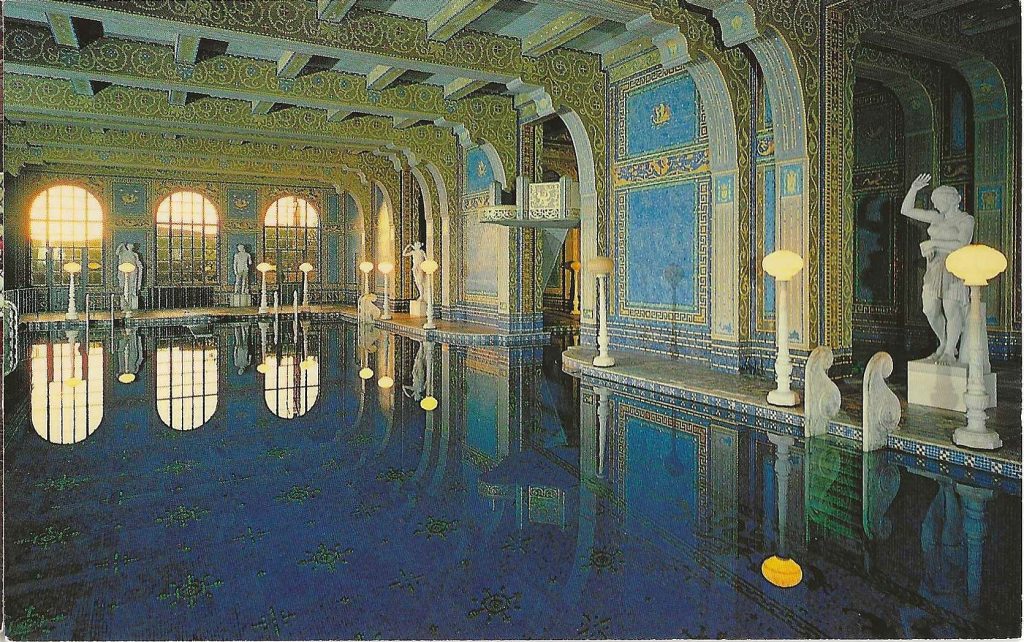
The Roman Pool. This 81- by 31-foot Roman Pool was hand-set with a half-million lapis-lazuli and gold leaf tiles from the glassblowing island of Murano. The depth and clarity of the mosaics make the water appear deeper no matter where the viewer stands. The marble statues and the alabaster lamplight quiver in the indigo water, giving the huge room a nervous liquid beauty by day and a moonlit grotto effect by night.

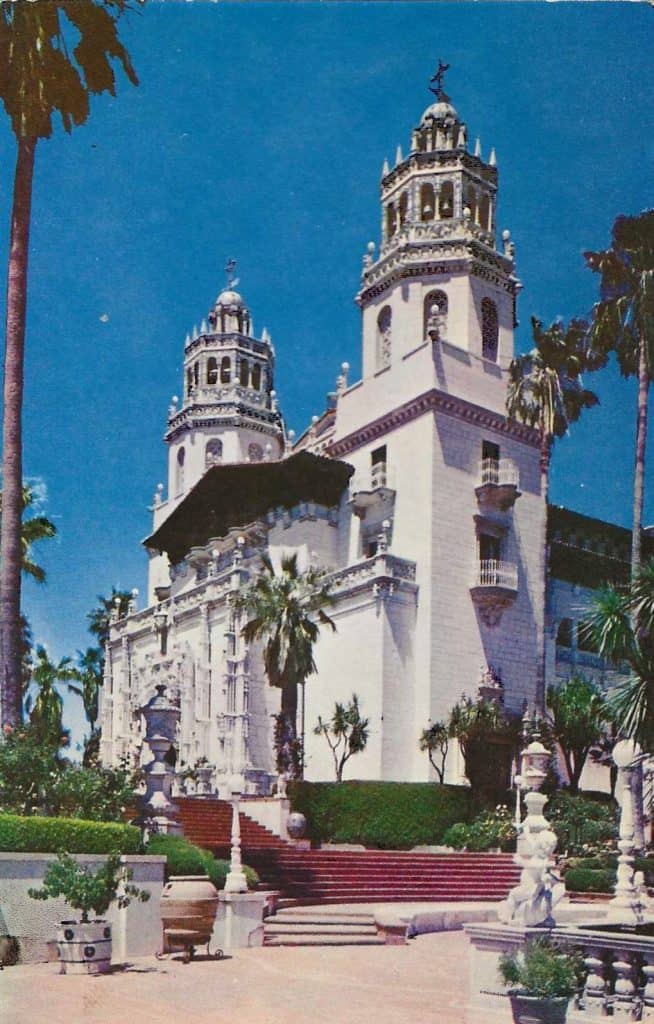
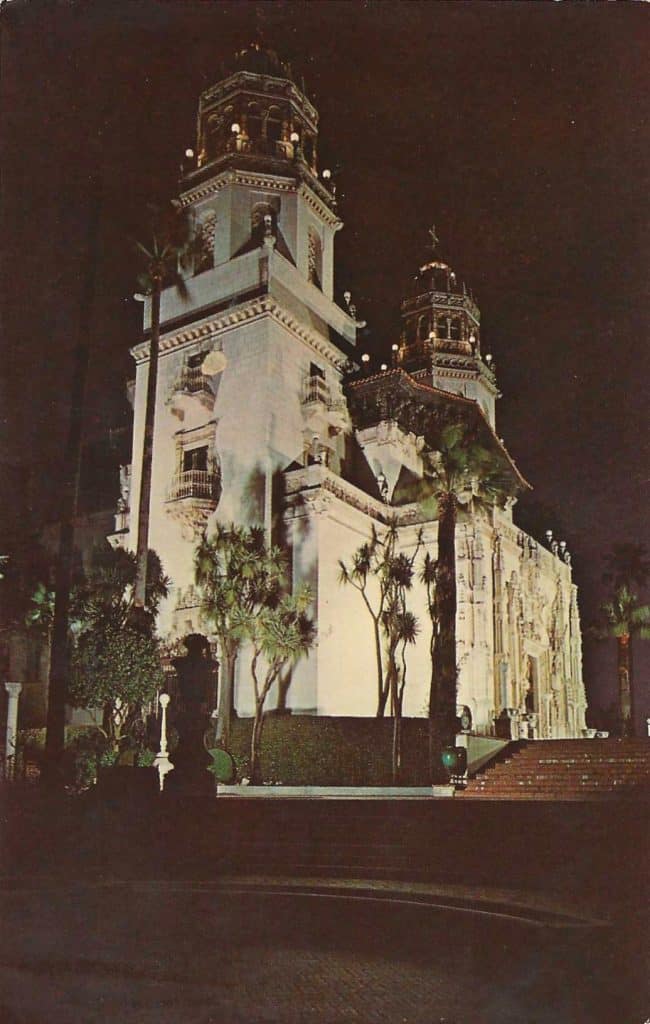
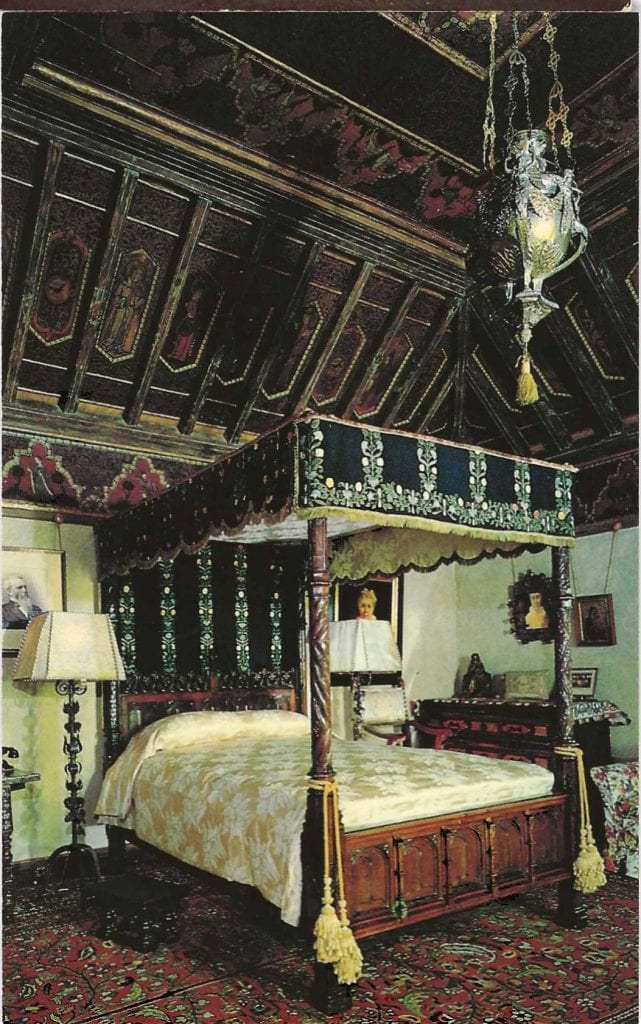
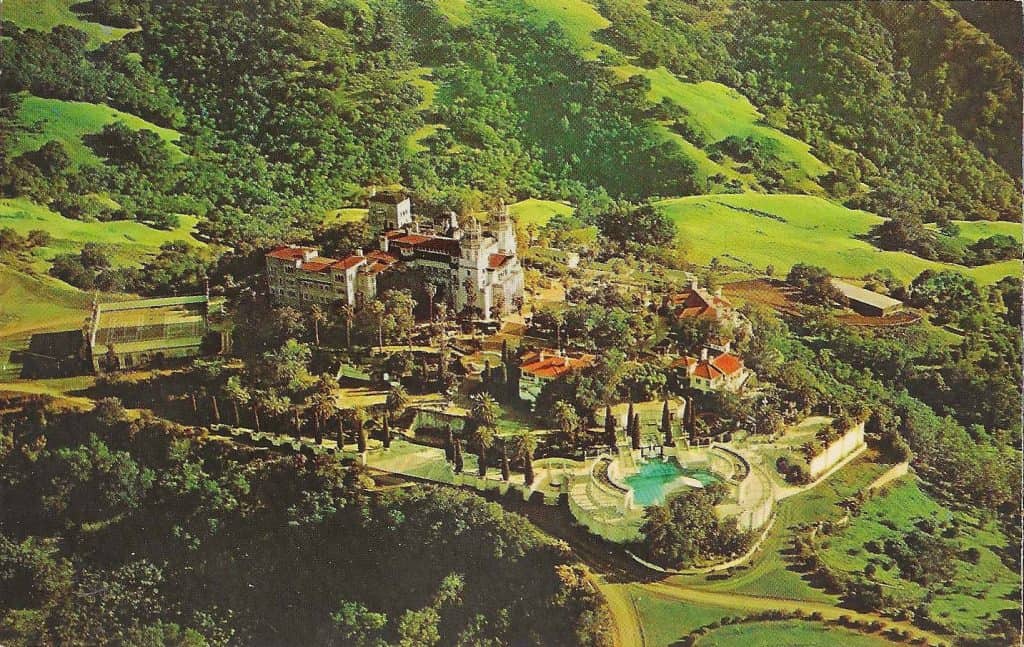


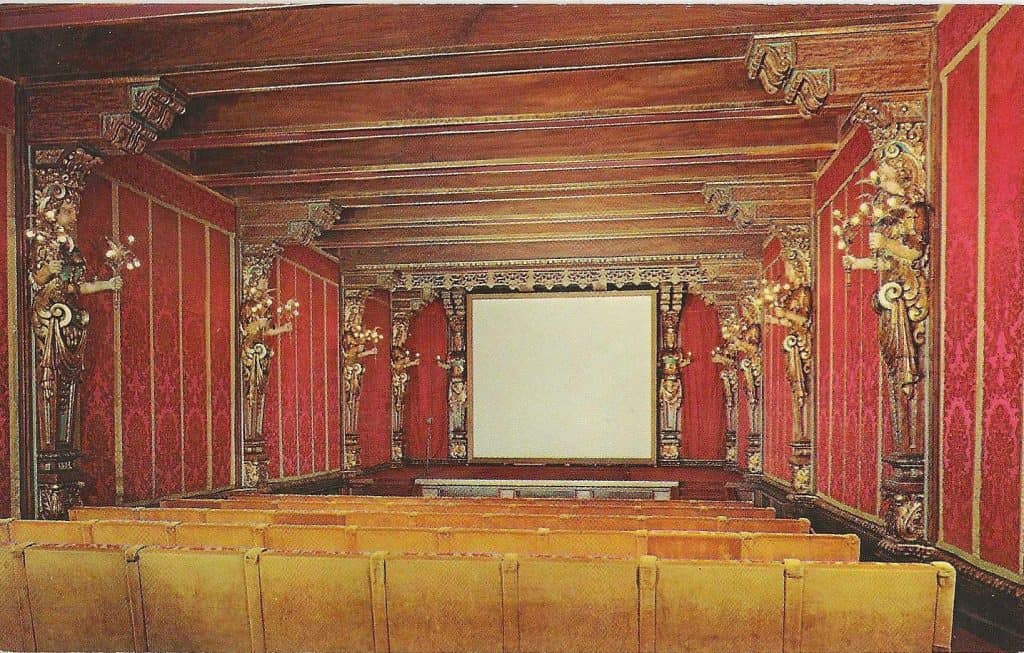
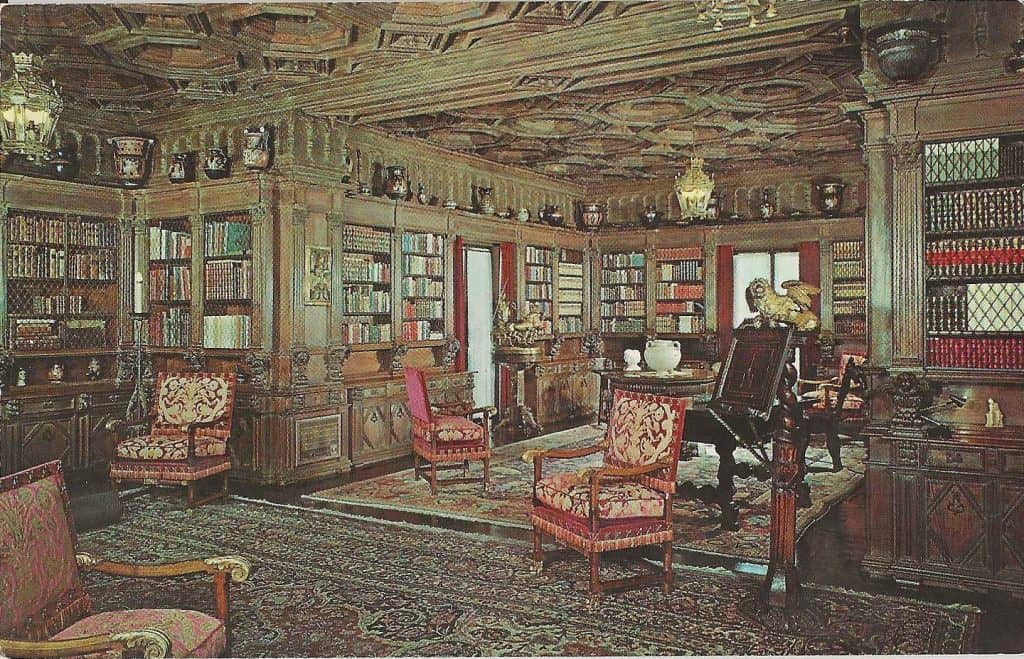

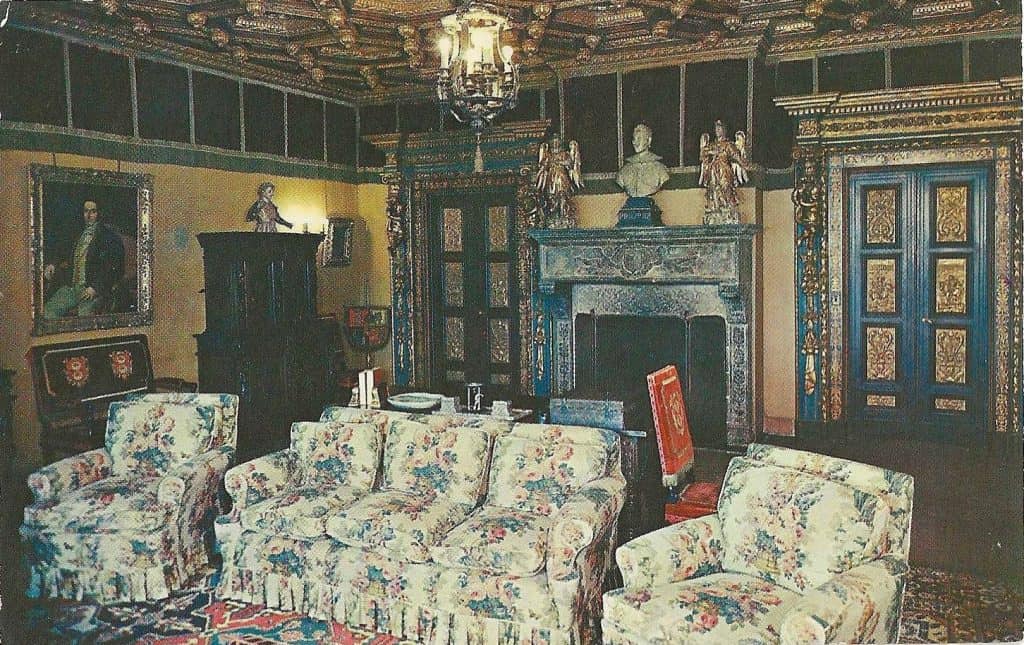
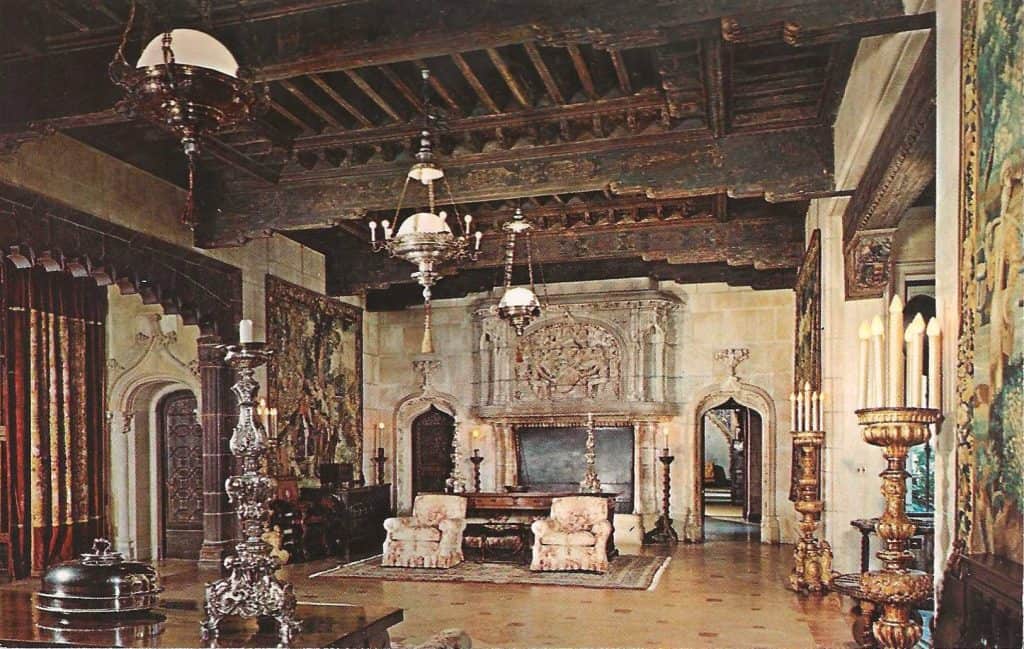
I have a different postcard view of the Morning Room, and one of the Assembly Room. I always loved that pool. Happy World Postcard Day.
What a place! I was there in summer of 1991. It was a pleasure to read this article.
One of my favorite all time memories. It was so beautiful to visit. Dad took us in the 70’s. I wish I could find his postcards from that trip.